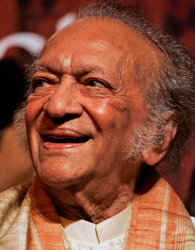Ravi Shankar, India’s most famous sitar player and composer, is credited with popularizing Indian music in the Western world, and with influencing musicians in many genres, including folk, jazz and rock.
Ravi Shankar’s Early Days
Ravi Shankar was born Robindra Shankar Chowdhury in Benares, a holy city on the River Ganges in India’s United Province on April 7, 1920. His older brother Uday formed an Indian dance troupe that Ravi joined when he was 10.
The dance troupe was how Shankar first came under the spotlight, performing for audiences in North America, Europe and India. In 1935, Ustad Allauddin Khan, joined the troupe, and soon after became Shankar’s mentor. Shankar moved back to India to study intensively with Khan through a method known as guru-shishya. Shankar married Khan’s daughter Annapurna in 1941 and their son, Shubhendra, was born the following year.
Sources in this Story
- Encyclopaedia Brittanica: Ravi Shankar, Indian Musician and Composer
- New York Times: Ravi Shankar, Sitarist Who Introduced Indian Music to the West, Dies at 92
- Time: Sitar Player
- The BBC: Grammy for Indian sitar maestro
- Ravi Shankar: A Short Biography
- The Observer: Rock’n’roll sitar hero
- NPR: Ravi Shankar, Master of the Sitar
Shankar’s Notable Accomplishments
Shankar, who had adopted Ravi as his stage name, began performing his sitar on stage in 1939 and on All-India Radio in 1940. Time magazine, in a 1957 review of a performance of Shankar’s at Judson Memorial Hall in New York City, described the sitar and its music for the American audience. Shankar’s radio performances included duets with Ali Akhbar Khan, the son of his guru Ustad and a famous sarod player. In 1945, Shankar moved to Mumbai and composed scores for ballets and films, including the ballet “The Discovery of India” based on the writings of Prime Minister Jawaharlal Nehru. Following this, Shankar served as Director of Music at All-India Radio from 1949-1956.
By composing music for musicians from around the world, including the Beatles, Philip Glass and the flautist Jean Pierre Rampal, Shankar was an “ambassador” of Indian music, and joined the complex music of the sitar with eastern instruments like the shakuhachi, a Japanese bamboo flute, and the koto, a Japanese floor harp. He was decorated for these efforts when he was inducted to the American Academy of Arts and Letters and bestowed France’s Commandeur de l’Ordre des Arts et des Lettres, among other prominent awards and honorary doctorates. Shankar also attended seminal concerts like Woodstock and was named the “Godfather of World Music” by George Harrison.
Shankar was also nominated, along with George Fenton, for an Academy Award for the score of 1982’s “Gandhi.” He has won three Grammys, including one in 2002 for the live album “Full Circle,” recorded at Carnegie Hall in London in 2000. The BBC reported on the award and Shankar’s influence in the western world.
The Man and His Work
- The Ravi Shankar Foundation
- AllMusic: Ravi Shankar Discography
- “Passages” by Ravi Shankar and Philip Glass
- “Full Circle: Carnegie Hall 2000” by Ravi Shankar
- “My Music, My Life” by Ravi Shankar
The Rest of the Story
Among his other vocations, Shankar spent six years (1986-1992) as a member of Indian parliament.
Shankar divorced his first wife in 1958 and was then in a relationship with Sue Jones; their daughter, Norah Jones, is an acclaimed singer-songwriter, pianist, guitarist and keyboardist. Shankar then married Sukanya Shankar, and their daughter is the successful sitarist Anoushka Shankar.
Playing the sitar is “like driving through a mist,” Shankar once told Time magazine. “The more you drive, the more you realize the road is still there.” In an interview with NPR in 2005, Shankar added that he thinks of his music as “a prayer.”
Shankar died December 11, 2012, a few days after undergoing heart valve replacement surgery. He was 92.
This article was originally written by Liz Colville; it was updated March 6, 2017.











